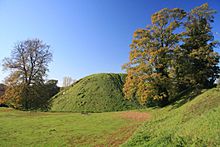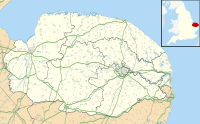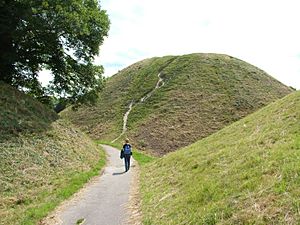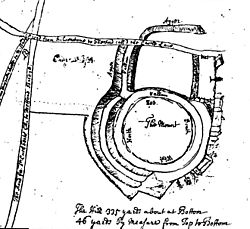Thetford Castle facts for kids
Quick facts for kids Thetford Castle |
|
|---|---|
| Norfolk, England | |

Thetford Castle
|
|
| Coordinates | 52°24′40″N 0°45′17″E / 52.4112°N 0.7547°E |
| Type | Motte and bailey |
| Site information | |
| Owner | Local authority |
| Open to the public |
Yes |
| Condition | Earthworks remain |
| Site history | |
| Events | Revolt of 1173–1174 |
Thetford Castle is a medieval castle found in the town of Thetford in Norfolk, England. It was a type of castle called a motte and bailey. The first castle in Thetford was a smaller Norman "ringwork" called Red Castle, built in the 11th century. Later, in the 12th century, a much bigger motte and bailey castle was built on the other side of town.
This new castle was mostly destroyed in 1173 by King Henry II. However, its huge motte, which is a large artificial hill, remained. This motte is the second largest man-made mound in England! Today, the motte is part of a local park. It is known by different names like Castle Hill, Castle Mound, and Military Parade. It is also a protected historical site.
Contents
History of Thetford Castle
Building the First Castle (11th Century)
In the 11th century, Thetford was a very important town in England, especially in the eastern part. It was the second largest town in an area called East Anglia. The name "Thetford" means "the ford," which was a shallow place to cross a river. It was a key spot on an old road called the Icknield Way. Thetford was also a busy place for trade and making pottery.
Before the castles, an old earth and timber fort from the Iron Age was on this site. By the late Saxon period, the town had a protective ditch around it, like a fence. The first castle, Red Castle, was probably built by William de Warenne soon after the Norman conquest of England. This castle was a "ringwork" design, which means it had a circular bank and ditch. It was built right across the town's old defensive ditch, even cutting off a local church and building over part of a cemetery.
The Grand New Castle (12th Century)
By the year 1100, a powerful noble named Roger Bigod controlled Thetford. He decided to build a brand new, much larger motte and bailey castle. He chose a spot that could protect both the town and the important river crossings of the River Thet and the Little Ouse on the Icknield Way.
The most important part of this new castle was its enormous motte, or artificial hill. It was surrounded by a deep ditch. On its north side, it had two sets of strong ramparts, which were probably part of the older Iron Age defenses. This motte is truly huge: it's about 19.6 meters (64 feet) high, and 22 meters (72 feet) high from the bottom of its ditch. It's also 100 meters (328 feet) wide at its base. This makes it the second largest man-made hill in all of England!
A large timber (wooden) tower, called a keep, would have stood on top of the motte. The castle also had a rectangular "bailey," which was a protected courtyard area. This bailey was about 105 by 95 meters (344 by 312 feet) and used the old Iron Age defenses on one side. The new castle would have looked very impressive and powerful, towering over the old Saxon town.
The castle's earthworks were built using local chalk. The ditches dug around the castle didn't provide enough material for the huge mound. People believe that much of the earth came from a nearby area called Gallows Pits. The castle was built by hand, with workers using wooden shovels. It's thought that building just the motte took about 24,000 days of work from many people!
The Bigod family became very powerful in the region, thanks to their strong castles like Thetford, Framlingham, Bungay, and Walton. Roger's son, Hugh Bigod, was involved in a civil war known as the Anarchy. He rebelled against King Stephen from his castles. It seems that a stone wall was built around the bailey, and maybe even a stone keep on the motte, around this time.
However, when Henry II became king, he wanted to make royal power stronger. In 1157, Henry took control of Bigod's castles. He later gave Framlingham and Bungay back but kept Thetford Castle for himself. Hugh Bigod then joined a rebellion by Henry's sons. He took control of Thetford Castle again, but in 1173, Henry's forces captured the castle and destroyed its defenses. The huge mound, however, was too strong to be destroyed.
Later Years (13th–20th Centuries)
After the 12th century, Thetford became less important, and the castle was not used much. Even so, as late as 1558, the "Castle Yard" was still in use and was said to have a stone wall around it. In 1772, part of the outer bailey (the east bank) was destroyed. In 1823, some elm trees were planted near the top of the mound.
People were always curious about where the castle came from. For a while, its true history was forgotten. Some local stories said the mound was made by the devil! But by the Victorian period, experts realized it was either built by the ancient Celts or the Normans. Later, they correctly figured out it was most likely from the Norman period. Other stories claimed the mound covered a palace full of treasure, or six silver bells from Thetford Priory.
Archaeologists, like G. Knocker in 1957–58 and R. R. Clarke and Barbara Green in the early 1960s, investigated Red Castle. Their work helped us understand how and when this first castle was built.
Thetford Castle Today (21st Century)
Today, the large motte is owned by the local government and is part of Castle Park. The area that was once the castle bailey is now called Military Parade. The entire site is a scheduled monument, which means it's a very important historical place protected by law.




